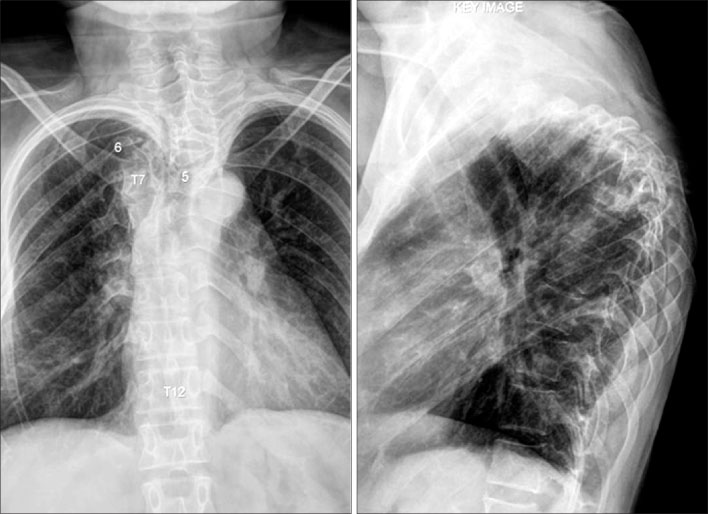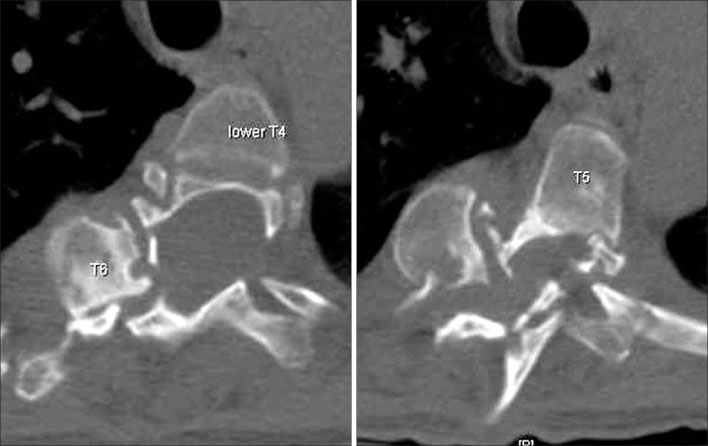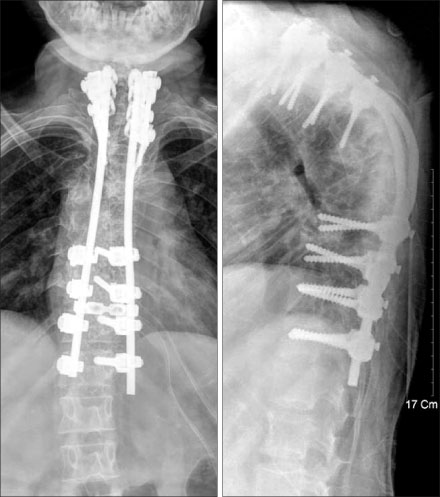J Korean Orthop Assoc.
2007 Dec;42(6):822-827. 10.4055/jkoa.2007.42.6.822.
Spontaneous Vertebral Column Dislocation in Neurofibromatosis: A Case Report
- Affiliations
-
- 1Department of Orthopaedic Surgery, School of Medicine, Kyung Hee University, Seoul, Korea. shl6@khu.ac.kr
- KMID: 1947791
- DOI: http://doi.org/10.4055/jkoa.2007.42.6.822
Abstract
- The dystrophic type of neurofibromatosis is a well-known bizarre deformity of the spine. There has been little literature about spontaneous vertebral column dislocation in the thoracic spine with progressive neurological symptoms. The authors present a case of thoracic spine dislocation vertically and transversely with intact posterior elements. A 35-year-old woman had stooping and back pain for five years. She developed motor weakness of both lower extremities three months ago. Plain X-ray and three-dimensional CT scans showed dislocation between T5 and T6 vertebrae, that were which was translated transversely and vertically with severe resorption of vertebral pedicles of T5 and T6. After skeletal traction, motor weakness was improved. And we performed two-staged anterior and posterior fusion to stabilize severe kyphoscoliosis. The patient was improved neurologically with free ambulation state at 24-month follow-up. Combined anterior and posterior fusion was an effective method for the treatment spontaneous vertebral column dislocation in the thoracic spine with progressive neurological symptoms.
MeSH Terms
Figure
Reference
-
1. Akbarnia BA, Gabriel KR, Beckman E, Chalk D. Prevalence of scoliosis in neurofibromatosis. Spine. 1992. 17:Suppl 8. S244–S248.
Article2. Crawford AH, Al-Sayyad MJ. Clark R, editor. Miscellaneous conditions of the cervical spine. Neurofibromatosis, juvenile rheumatoid arthritis, and Rickets. The cervical spine. 2004. 4th ed. Philadelphia: Lippincort Williams and Wilkins;481–507.3. Goldberg NS, Collins FS. The hunt for the neurofibromatosis gene. Arch Dermatol. 1991. 127:1705–1707.
Article4. Kim HW, Weinstein SL. Spine update. The management of scoliosis in neurofibromatosis. Spine. 1997. 22:2770–2776.5. Parisini P, Silvestre M, Greggi T, Paderni S, Cervellati S, Savini R. Surgical correction of dystrophic spinal curves in neurofibromatosis. Spine. 1999. 24:2247–2253.
Article6. Rockower S, McKay D, Nason S. Dislocation of the spine in neurofibromatosis. A report of two cases. J Bone Joint Surg Am. 1982. 64:1240–1242.
Article7. Simpson AH, Williamson DM, Golding SJ, Houghton GR. Thoracic spine translocation without cord injury. J Bone Joint Surg Br. 1990. 72:80–83.
Article8. Stone JW, Bridwell KH, Shackelford GD, Abramson CL. Dural ectasia associated with spontaneous dislocation of the upper part of the thoracic spine in neurofibromatosis. A case report and review of the literature. J Bone Joint Surg Am. 1987. 69:1079–1083.
Article9. Winter RB. Spontaneous dislocation of a vertebra in a patient who had neurofibromatosis. Report of a case with dural ectasia. J Bone Joint Surg Am. 1991. 73:1402–1404.
Article10. Winter RB, Lonstein JE, Anderson M. Neurofibromatosis hyperkyphosis: a review of 33 patients with kyphosis of 80 degrees or greater. J Spinal Disord. 1988. 1:39–49.
- Full Text Links
- Actions
-
Cited
- CITED
-
- Close
- Share
- Similar articles
-
- Endovascular Treatment for Spontaneous Vertebral Arteriovenous Fistula in Neurofibromatosis Type 1: A Case Report
- Coil Embolization of Spontaneous Vertebral Arteriovenous Fistula Associated with Neurofibromatosis Type 1: A Case Report
- Recurrent Shoulder Dislocation and Proximal Humerus Fracture in Neurofibromatosis Type I: A Case Report
- Spontaneous Extracranial Vertebral Artery Dissection in a Neurofibromatosis 1 Patient with Bilateral Intrathoracic Spinal Meningoceles around the Scoliosis: Report of an Autopsy Case
- Spontaneous Hemothorax Caused by Rupture of an Intercostal Artery Aneurysm in Neurofibromatosis Type I I : A Case Report






